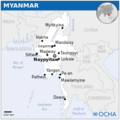Knowledge fuels change - Support energypedia!
For over 10 years, energypedia has been connecting energy experts around the world — helping them share knowledge, learn from each other, and accelerate the global energy transition.
Today, we ask for your support to keep this platform free and accessible to all.
Even a small contribution makes a big difference! If just 10–20% of our 60,000+ monthly visitors donated the equivalent of a cup of coffee — €5 — Energypedia would be fully funded for a whole year.
Is the knowledge you’ve gained through Energypedia this year worth €5 or more?
Your donation keeps the platform running, helps us create new knowledge products, and contributes directly to achieving SDG 7.
Thank you for your support, your donation, big or small, truly matters!
Burma (Myanmar) Energy Situation
Capital:
Naypyidaw
Region:
Coordinates:
22.0000° N, 96.0000° E
Total Area (km²): It includes a country's total area, including areas under inland bodies of water and some coastal waterways.
XML error: Mismatched tag at line 6.
Population: It is based on the de facto definition of population, which counts all residents regardless of legal status or citizenship--except for refugees not permanently settled in the country of asylum, who are generally considered part of the population of their country of origin.
XML error: Mismatched tag at line 6. ()
Rural Population (% of total population): It refers to people living in rural areas as defined by national statistical offices. It is calculated as the difference between total population and urban population.
XML error: Mismatched tag at line 6. ()
GDP (current US$): It is the sum of gross value added by all resident producers in the economy plus any product taxes and minus any subsidies not included in the value of the products. It is calculated without making deductions for depreciation of fabricated assets or for depletion and degradation of natural resources.
XML error: Mismatched tag at line 6.2 ()
GDP Per Capita (current US$): It is gross domestic product divided by midyear population
XML error: Mismatched tag at line 6. ()
Access to Electricity (% of population): It is the percentage of population with access to electricity.
XML error: Mismatched tag at line 6.no data
Energy Imports Net (% of energy use): It is estimated as energy use less production, both measured in oil equivalents. A negative value indicates that the country is a net exporter. Energy use refers to use of primary energy before transformation to other end-use fuels, which is equal to indigenous production plus imports and stock changes, minus exports and fuels supplied to ships and aircraft engaged in international transport.
XML error: Mismatched tag at line 6.no data
Fossil Fuel Energy Consumption (% of total): It comprises coal, oil, petroleum, and natural gas products.
XML error: Mismatched tag at line 6.no data
Introduction
Republic of the Union of Myanmar also known as Burma is the second largest country in Southeast Asia. The most productive industry in Burma are power industry and oil as well as gas. These industries are also opened for foreign investment, with China being the leading foreign investor.[1]
Energy Situation
In 2009, the traditional biomass (70%) has the largest share in primary energy supply, followed by natural gas (18%), oil (9%), hydro (2%) and coal(1%). In terms of electricity generation (2010-2011) hydro (72%) has the largest share followed by the natural gas (23%), coal (5%) and oil.[1]
To see the map of the "national grid system" in Myanmar, click here.
Currently (2016), the per capita electricity consumption is only around 150-160kWh, this is very low compared to others (India 680kWh; Vietnam 1,280kWh). [2]
As part of the National Electrification Project (NEP) in Myanmar, 1300 villages in rural areas will be electrified using solar power in FY 2019-20. The villagers will have to cover 20% of the power-generation cost while the rest will be covered by the government. The targeted villages are located in Mandalay, Magwe, Bago, Irrawaddy and Tanintharyi regions.[3]
NEP also aims to achieve 100% electrification by 2030. In its first phase, NEP aims to provide electricity access to over 620,000 households in some 5,000 villages within a 2-mile radius of the national grid across the country. The first phase is expected to complete in June 2020. In its second phase, electricity will be supplied to villages within a 5-mile radius of the grid.[3]
Electricity Tariff
Myanmar has one of the lowest electricity tariffs in the world. Effective April 2014, residential tariffs range from Ks 35 - Ks 50 per kWh [USD 0.026 - 0.037, Exchange rate of June 2018]. First 100 units are billed at Ks 35/kWh, next 100 units cost Ks 40/kWh and units beyond 200 kWh cost Ks 50/kWh.
Prices for commercial and industrial customers are higher, ranging from Ks 75/kWh - Ks 150/kWh, according to the below consumption structure:
| <500 kWh | Ks 75 |
| 501–10,000 kWh | Ks 100 |
| 10,001–50,000 kWh | Ks 125 |
| 50,001–200,000 kWh | Ks 150 |
| 200,001–300,000 kWh | Ks 125 |
| >300,001 kWh | Ks 100 |
Further information
Tim Dobermann: Energy in Myanmar. Policy Brief. 2016 (International Growth Centre): http://www.theigc.org/wp-content/uploads/2016/04/Dobermann-2016.pdf
- Electricity development; access; policies; summary of a key research agenda for the country
Reference
- ↑ 1.0 1.1 http://aseanrenewables.info/wp-content/uploads/2013/05/MM-Myanmar_Rev02.pdf
- ↑ Dobermann, Tim. ‘Energy in Myanmar’, 2016. http://www.theigc.org/wp-content/uploads/2016/04/Dobermann-2016.pdf.
- ↑ 3.0 3.1 https://www.irrawaddy.com/news/burma/1300-villages-receive-solar-generated-electricity-fy2019-20.html





















